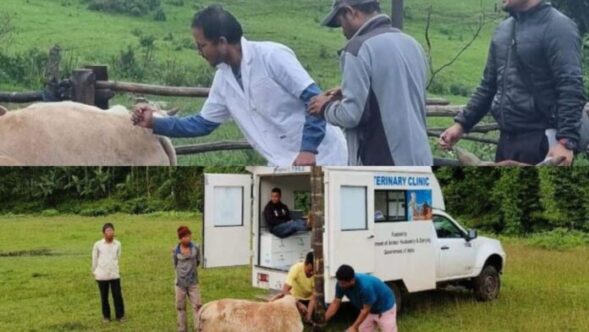
By Eleanor A. Sangma
In Odisha, there is a group of women who are called ‘people of the spirit world’. They ink their skin with tattoos, said to be markers of their identity in the realm of the spirits.
The Kutia Kondh tribe, like several tribes across the world, use tattoo as an important symbol of tribal culture.
With the intention of reviving this dying art, a Delhi-based tattoo artist has taken on the challenge of travelling across India in search of traditional knowledge.
Amit Arjel started his career as a tattoo artist in the year 2014. “I had gone to a studio for my first tattoo in Delhi, my own design in hand. The tattoo artist there was quite impressed with my creation and eventually persuaded me to join the industry,” he recalled.
 He started learning the fundamentals of tattooing in the studio, a year of perfecting his lines and shading. His first real tattoo, after months of working on artificial skin, was done on himself before anyone else. “This was so I could see how much pressure and pain I’m supposed to apply on my clients and to study the healing process. I observed the changes to my skin each day so I could explain the same to others.”
He started learning the fundamentals of tattooing in the studio, a year of perfecting his lines and shading. His first real tattoo, after months of working on artificial skin, was done on himself before anyone else. “This was so I could see how much pressure and pain I’m supposed to apply on my clients and to study the healing process. I observed the changes to my skin each day so I could explain the same to others.”

Routine, however, was never meant for certain individuals. After several years, doing the same tattoos became monotonous for the artist. “I’ve always been into unique elements. I got tired of doing name tattoos and the same flowers again and again. So, I started researching our Indian tribal cultures.”

While doing his research, he discovered the Baiga women who have traditionally marked their skin with elaborate tattoos. As fate would have it, he got connected with a woman from the tribe who does traditional hand-poked tattoos. When he asked her if he could learn the art from her, she was very welcoming. “It took me about a month to learn about motifs, the culture, and the technique of hand-poked tattoos. It sparked an interest in me regarding all aspects of the tribal tattoo culture – how they prepare their ink from natural resources and how they make their needles, among others. All aspects are unique and connected to nature, which is what drew me into the art form.”

Arjel, thus, embarked on a journey of safeguarding cultural elements of the varying tribes of India.
For him, a tribal tattoo is a doorway to one’s culture. “If you get an Indian tribal tattoo, rather than just a marking on skin, you’re welcoming a whole culture with a tiny symbol. Suppose someone asks what your tattoo means… you tell them what it represents and then talk about your culture. That is how people get interested to learn and know more.”
Speaking of the taboo surrounding tattoos, especially in smaller regions such as Garo Hills, Arjel pointed out that there is less knowledge about tattoos amongst the older generation. Misconceptions are also pervasive in society. However, he has high hopes for the future of tribal tattoos in the region.
“Once they know how it represents their culture, past, present or future, they will be more open to it. You just have to tell them, ‘I got this because I feel connected with my tribe.’”
A.chik tribe does not have a tradition of tattooing – few have realised their traditional motifs can be used for the same.
In the contemporary world, there are many who desire to connect to their culture and roots, which open up doors for exploration. People of the region have got excited and curious, as this is uncharted territory.
He (Arjel) recounted his experience doing his first A.chik tribal tattoo just a year back. He was working under Daisy Momin (artisan), learning about the traditional motifs, and told her about his goal to represent these cultural symbols and stories through tattoos.
“While I was working on my sketches, she got excited and told me she wanted one tattooed on her. This is interesting to me because she belongs to a generation that has never been into such forms of expression,” he said.
Once he was done with her tattoo, others came through, like a chain reaction. He tatted the same motif for some 11-12 people. “Tattoo is the only medium I can use to tell stories,” he added.
His goal is to visit every possible tribal community in India to learn about their culture and motifs. “I can represent them through this form of art. When we look at Maori and Polynesian communities, we can see that they have rich cultural motifs represented through tattoos. They keep records of everything, but we don’t. There is no one who can go visit our tribes to record and archive everything. So, my motive is to officially record and preserve such knowledge.”
The artist shared he has to face his own share of troubles when researching tribes, due to minimal information and sources. He aims to become a treasure trove of knowledge and help others preserve the same through varied forms of art.
For thousands of years, tattoos have served as a form of expression, of the self, of love and care. Etched onto one’s skin, it is a reminder of who we are as individuals and as a community.
Despite language and cultural barriers, Arjel has been travelling across India in search of stories. He said, “Cultural etiquettes are different for each tribe. I try to do my own research before visiting them so I can understand them better and respect their way of life. Tribals are extremely giving, the only thing they ask in return is respect.”
He added, “If the younger generation respects the tribal art forms, through tattoos, textiles or any other forms, it is the only way we can save our tribes from becoming extinct. We have that responsibility. The ones who came before us have done what they could.”






